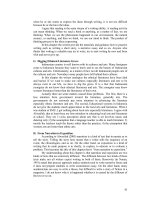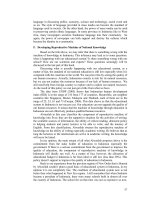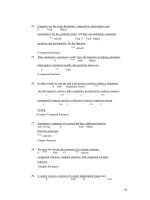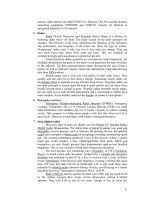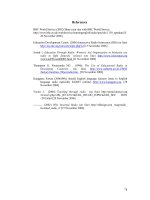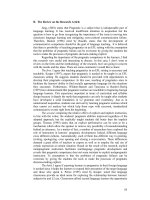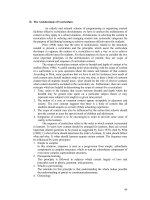Teaching and learning english part 9
Bạn đang xem bản rút gọn của tài liệu. Xem và tải ngay bản đầy đủ của tài liệu tại đây (404.32 KB, 7 trang )
57
language in discussing politic, economy, science and technology, social event and
so on. The style of language provided in mass media can become the standard of
language used in society. On the other hand, the power of mass media can be used
in preserving certain ethnic languages. In some province in Indonesia like in West
Java, many newspapers socialize Sundanese language into their community. So
again, the power of newspaper can both support and destroy the cultures which
become the identity in a community.
F. Developing Reproductive Machine of National Knowledge
Based on the title above, we may infer that there is something wrong with the
machine of knowledge in Indonesia. This inference may lead us to some questions:
what is happening with our educational system? Is there something wrong with our
school? How are our scientists and experts? These questions seemingly will be
discussed in the last part of this book.
Discussing what is actually happening with our educational system, as a
matter of fact, the standard of our national education is still low especially when it is
compared with the countries in the world. We can prove this by seeing the quality of
our human resources. Actually, Indonesian country is rich for its natural resources,
but we can not explore the resources because of our lack of human resources. We
still need help from foreign country to explore and to exploit our natural resources.
As the result of this policy we can just get a little from what we have.
The data from UNDP (2005) shows that Indonesian human development
index (HDI) is in the range of 110 from 177 of countries. Meanwhile, our neighbor
countries like Singapore, Brunei, Malaysia and Thailand, each of them are in the
range of 25, 33, 61 and 73 (Furqan, 2006). This data shows us that the educational
system in Indonesia is not success yet. Our education can not upgrade the quality of
our human resources. It means that the machine of knowledge through education in
Indonesia can not effectively produce qualified human resources.
Alwasilah in this case classifies the component of reproductive machine of
knowledge into fives; they are the supportive situation for the activities of writing,
the available sources of information, the ability of critical reading, democrat policy
in helping students and junior lecturer to be able to write, and the mastery of
English. From this classification, Alwasilah stresses the reproductive machine of
knowledge on the ability of writing especially academic writing. He believes that as
long the lecturers or the intellectuals are active in academic writing, the knowledge
will never be lasted.
In my opinion, the main stream of all what Alwasilah proposes above is the
commitment from the stake holder of education in Indonesia especially the
government. If there is a serious commitment from the government to improve the
quality of education, the component of reproductive machine of knowledge in
Indonesia will ideally run well. As a matter of fact, however, the allocation of
educational budget in Indonesia is far from ideal or still low (less than 20%). This
policy doesn’t support to improve the quality of education in Indonesia.
Back to our experience from the previous regime of New Order that is blamed
by Alwasilah couldn’t plant a good basic of educational system in Indonesia, in my
opinion it is not completely true. The condition of educational system now is not
better than what happened in New Era regime. I still remember that when Soeharto
became a president of Indonesia, there were many schools built in almost all over
the country of Indonesia. The school fee on that time was not as expensive as now.
58
Many students and lecturers were sent to abroad to study in many top universities in
the world. On the other hand, many students from abroad also study in Indonesia
which shows the quality of our education.
Today, the education in Indonesia is very expensive especially at university.
Only the people who come from wealthy families can get a good education. They
who do not have much money can only follow the education until primary school.
The result is the wealthy will be richer, and the poor are poorer. All of these
happened caused by the complexity problems faced by Indonesia from the economic
until the morality crisis.
Actually the crisis happened in Indonesia can not be separated from the
unsuccessfulness of education in Indonesia. The educational system can not
strongly plant the morality to the students. I agree with Alwasilah that our education
should build up cultural literacy to the students, but in my opinion the strong planted
of morality is more important. The cultural literacy should be the target of education
in Indonesia. To overcome the crisis problems, however, the cultural literacy only is
not enough. The educations also have to plant the morality to the students. The
basic knowledge and skills in joining their social interaction in their community
have to place the morality forward.
The culture literacy that places the morality will be the basic foundation in
revitalizing the culture and develop the quality of education in Indonesia. The
society will be creative in finding the alternatives solutions through critical thinking,
judging the value which is suitable to the situation or time, and improving the
quality of life and adaptation in facing the modernization and globalization era.
G. Conclusion
From the discussion above, I have drawn the conclusion and suggestion as
follows:
I agree with Alwasilah that every ethnic has the same right to preserve their
culture and identity. The essence of cultural revitalization is preserving the
essentials of culture, which basically an act of documenting cultural fact, artifacts
and texts for effortless access in the future. To revitalize the culture is not an easy
thing to do. The revitalization has to be done collectively and well planed. We can
not make such a planning without any understanding and the awareness. In case of
Sundanese, the most difficult effort to do is to unite the understanding the awareness
in one vision to revitalize their identity.
Mother tongue is the language acquired by someone for the first time. It has a
great influence to how someone thinks and behaves. Historically Indonesia language
was formed from many mother tongues from all over ethnic in Indonesia. In this
case I suggest that mother tongues must be preserved to help and to enrich the
Indonesia as our national language.
One of the characteristics of civil society is when the civilians are developed
with the culture of reading and writing. The writing activity plays an important role
to develop the quality of society. In this case mass media plays the important role.
The power of mass media can be used in revitalizing culture and the identity of life.
The revitalization also needs a good educational system as a reproductive
machine of knowledge. The culture literacy that places the morality will be the basic
foundation in revitalizing the culture and develop the quality of education in
Indonesia. Now, we are waiting for the government policies to reorient the
educational system.
59
Bibliography
Furqan. (2006). “Penilaian Hasil Belajar untuk Meningkatkan Mutu Pendidikan.
Makalah pada forum ilmiah II FPBS UPI, Bandung.
Haerudin, Dingding, (2006). “Meningkatkan Kesadaran Berbahasa Sunda.”
Pikiran
Rakyat
21 Februari 2006
Oetama, J. (2005).
Powering the Media Dynamics. [Online]
561.htm
. [10
Desember 2006]
Rahbar. (2006)
Peran Positif dan Negatif Media Massa. [Online]
bir/perspektif/2006/05mei/media.htm
[10 Desember 2006]
Sugono, Dedi. (Suara Merdeka, 3 Februari 2004). Meningkatkan Daya Ungkap
Bahasa.
Suara Merdeka (Online), Tersedia: http://www.
suaramerdeka.com/harian/0402/03/kha2.htm
Taufikurraman. (Kompas, 13 April 2005). Tanda Keruntuhan Budaya Sunda.
Kompas (Online), Tersedia: kompas-
cetak/0504/13/jabar/1678328html.[10 Desember 2006]
60
ENGLISH SENTENCES
Muhammad Sukrianto
In this essay, we are going to discuss the English Sentences. We often say that the
main of languages are the sentences. The ability to use a language is when we can
produce our ideas in to sentences. The sentences can be produced in form of written
or spoken languages.
A sentence is the basic building block of written language. In the past, sentences
were often defined according to their meaning. For example, there were said to
contain “a complete thought”. This raises all sorts of questions about the difference
between a complete thought and incomplete one.
A common definition of a sentence is: “ a sentence is marked by a capital letter at the
beginning and full-stop at the end (Crown, 1996). This works for many English
sentences, but there are many languages, such as those in Asia, that do not use this
punctuation. Also it is possible to have written sentences without capital letters.
Another definition of sentences: “ A sentence contains a subject and a predicate
(Ramsay, 1986). It means that a sentence can be analyzed in to subject and predicate.
The predicate is all the rest of the sentence after the subject. Most English sentences
have three parts: a subject, a verb, and an object or complement. These sentences
called SVO sentences.
In order to find the three parts of an SVO sentences, first find the verb. After finding
the verb, look for the subject. The subject usually comes before the verb. Last, find
the object or complement. The object or complement comes after the verb.
The sentences can be classified according to their function. They are declarative,
imperative, interrogative and exclamatory. Linguists use the terms declarative,
imperative, interrogative and exclamatory for the syntactic forms, and they use
statement, command, question, and exclamation for the function. Thus, declarative
sentences usually have the function of making statement, interrogative sentences
usually ask questions and so on. In other words we can say that a
declarative
sentence
makes a statement, an interrogative sentence asks a question, An imperative
sentence
issues a command or request, and An exclamatory sentence expresses
strong feeling. Sometimes a sentence of a given kind has a different function from
the usual one.
We may also divide the sentences in to simple sentence, compound sentence,
complex sentence, and compound complex sentence.
A simple sentence consists of a
single independent clause and does not contain a subordinate clause. It may contain
compound subjects and predicates to express complex ideas while maintaining a
single main clause.
A compound sentence contains two or more coordinate clauses or
consist of two or more simple sentences separated by conjunctions. That means that
there are at least two units of thought within the sentence, either one of which can
stand by itself as its own sentence. The clauses of a compound sentence are either
separated by a semicolon (relatively rare) or connected by a coordinating conjunction
(which is, more often than not, preceded by a comma).
A complex sentence contains at least one main (independent) clause and one
subordinate (dependent) clause. A compound-complex sentence contains coordinate
61
and subordinate clauses or contains two principal clauses and one or more
subordinate clauses.
We have discussed The English sentences. We may have difficulty in recognizing
sentences, but the most important thing is we need to understand different kind of
sentences without necessarily knowing the appropriate labels for them.
The Analysis of English Sentences
1.
In this essay, we are going to discuss the English Sentences.
Adv S Verb Object
(Simple Sentences)
2.
We often say that the main of languages are the sentences.
S V Complement
S Adv freq Verb Dependent Clause
Object
(Complex Sentence)
3.
The ability to use a language is when we can produce our ideas in to
Art
(
Noun Phrase) Conj S Verb Object prep
S
Verb
Complement
sentences.
(Adv)
(Complex Sentence)
4. The sentences can be produced in form of written or spoken languages.
Art
S
Mod
Verb (Passive) Complement
(Simple Sentence)
5. A sentence is the basic building block of written language.
Art
S Verb
Art
Complement
Noun Phrase
(Simple Sentence)
6. In the past, sentences were often defined according to their meaning.
Adverb S Verb
Adv fre
Complement
(Simple Sentence)

